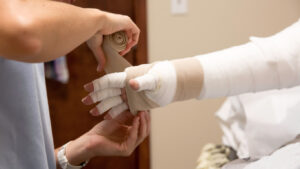Exercise for Lymphedema Patients: Types of Exercise to Reduce Swelling
Lymphedema is a chronic condition that results in swelling, most commonly in the arms and legs, due to a buildup of lymph fluid. This condition can be particularly prevalent among patients who have undergone treatments for breast cancer or other cancers, leading to what is known as cancer-related lymphedema. Engaging in a well-structured exercise program can significantly aid in managing lymphedema symptoms, reducing swelling, and enhancing overall physical well-being. In this article, we will explore the specific types of exercise recommended for lymphedema patients, how exercise can help manage the condition, the importance of compression garments during exercise, and how to create a safe exercise routine.
What Types of Exercise are Recommended for Lymphedema Patients?
Low-Impact Aerobic Exercises
Low-impact aerobic exercises are a cornerstone of an effective exercise program for lymphedema patients. Activities such as walking, cycling, swimming, and water aerobics are particularly beneficial as they promote circulation without putting undue stress on the joints. These forms of exercise help stimulate the lymphatic system, encouraging the movement of lymph fluid and reducing swelling. Regular participation in low-impact aerobic exercises can also improve cardiovascular health, enhance endurance, and maintain a healthy weight, which is crucial for individuals managing lymphedema. The key is to engage in these activities at a moderate intensity, ensuring that you can maintain a conversation while exercising, which indicates an appropriate level of exertion.
Resistance Exercises for Arms and Legs
Incorporating resistance exercises into your routine can play a significant role in lymphedema management. Strengthening exercises not only build muscle but also promote better lymphatic drainage. Patients with lymphedema are encouraged to focus on exercises for arms and legs that involve light weights or resistance bands. These exercises should be performed with controlled movements to avoid strain and potential lymphedema flare-ups. Resistance training can help improve muscle tone, enhance mobility, and support the overall function of the lymphatic system. It is advisable to start with lighter weights and gradually increase the resistance as your body becomes more accustomed to the exercise.
Flexibility and Stretching Exercises
Flexibility and stretching exercises are vital components of an exercise routine for lymphedema patients. These exercises help maintain a full range of motion and reduce stiffness in the affected areas. Gentle stretching can also assist in alleviating discomfort associated with swelling. Yoga and Pilates are excellent forms of exercise that incorporate flexibility training while emphasizing controlled movements and breathing techniques. Furthermore, these exercises can enhance relaxation, which may be beneficial for managing stress that can exacerbate lymphedema symptoms. Consistent practice of flexibility and stretching exercises can lead to improved physical function and quality of life.
How Can Exercise Help Manage Lymphedema Symptoms?
Understanding the Role of Physical Activity
Physical activity plays a crucial role in managing lymphedema symptoms. Exercise helps to stimulate the movement of lymph fluid through the lymphatic system, which is essential for reducing swelling. When engaging in regular exercise, the muscles contract and relax, creating a natural pump effect that aids in lymphatic drainage. This not only helps to reduce swelling but also minimizes the risk of lymphedema flare-ups. Additionally, exercise can improve overall physical fitness and enhance body awareness, allowing individuals to better manage their condition.
Benefits of Regular Exercise in Reducing Swelling
Engaging in regular exercise can provide numerous benefits for lymphedema patients. Studies and systematic reviews have demonstrated that consistent physical activity can lead to a notable reduction in swelling and improvement in symptoms. Exercise also helps to enhance circulation, reduce inflammation, and improve lymphatic function. Patients who maintain an active lifestyle often report greater mobility, increased energy levels, and an overall improvement in their quality of life. Furthermore, regular exercise can contribute to better mental health, helping to alleviate feelings of anxiety or depression that may arise from living with a chronic condition.
How Exercise Affects the Lymphatic System
The lymphatic system is a vital component of the body’s immune system, responsible for transporting lymph fluid and filtering out toxins and waste. Exercise can significantly enhance the function of the lymphatic system by promoting the efficient movement of lymph fluid throughout the body. When patients with lymphedema engage in physical activity, it stimulates lymphatic drainage, reducing the risk of swelling. Moreover, exercise helps maintain a healthy body weight, which is essential for minimizing the strain on the lymphatic system. By improving lymphatic circulation, exercise can be an effective tool in the management of lymphedema.
What is the Importance of Compression Garments During Exercise?
Choosing the Right Compression Garment
For lymphedema patients, wearing compression garments during exercise is crucial for minimizing swelling and enhancing the effectiveness of physical activity. These garments apply gentle pressure to the affected areas, helping to prevent the accumulation of lymph fluid. When selecting a compression garment, it is essential to consult with a certified lymphedema therapist who can recommend the appropriate level of compression and style based on individual needs. Compression garments come in various forms, including sleeves, stockings, and wraps, and should fit snugly but comfortably to ensure optimal support during exercise.
How to Use Compression Garments Effectively
To maximize the benefits of compression garments during exercise, it is important to wear them correctly. Before engaging in any physical activity, ensure that your compression garment is properly fitted and positioned. It is advisable to put on the garment first thing in the morning when swelling is typically at its lowest. Wearing compression garments throughout your exercise routine can help maintain consistent support, thereby enhancing lymphatic drainage and reducing swelling. Additionally, combining compression with regular exercise can lead to better overall outcomes in lymphedema management.
Potential Risks of Not Using Compression
Neglecting to use compression garments during exercise can result in a range of potential risks for lymphedema patients. Without the supportive pressure from compression garments, there is an increased likelihood of lymph fluid accumulation, leading to heightened swelling and discomfort. This can ultimately hinder the effectiveness of an exercise program and may lead to further complications, such as infections or skin issues. Therefore, it is essential to prioritize the use of compression garments as part of a comprehensive lymphedema management strategy.
Which Exercises are Best for Reducing Swelling in Lymphedema Patients?
Top Exercises for Arms to Alleviate Swelling
For patients with lymphedema, focusing on exercises for arms is vital to alleviate swelling and improve functionality. Simple movements, such as arm circles, wrist stretches, and light resistance band exercises, can significantly enhance lymphatic drainage in the upper extremities. Incorporating these exercises into your routine can lead to improved strength, flexibility, and reduced swelling in the arms. It is recommended to perform these exercises in a slow and controlled manner, paying attention to how your body responds to ensure you do not exacerbate your condition.
Effective Leg Exercises for Lymphedema Management
Leg exercises are equally important for lymphedema management, especially for patients experiencing swelling in the lower extremities. Simple activities such as ankle pumps, calf raises, and gentle leg lifts can promote circulation and help reduce swelling. Engaging in low-impact aerobic activities like cycling or swimming can also be beneficial for the legs. By incorporating these effective leg exercises into your routine, you can support lymphatic function and maintain overall mobility.
Integrating Deep Breathing with Physical Activity
Integrating deep breathing techniques with physical activity can enhance the effectiveness of an exercise program for lymphedema patients. Deep breathing promotes relaxation, reduces stress, and can even facilitate better lymphatic drainage. When combined with exercise, deep breathing can optimize oxygen delivery to the muscles, improving performance and endurance. Practicing deep breathing exercises before, during, and after physical activity can contribute to a more holistic approach to managing lymphedema symptoms.
How to Create a Safe Exercise Routine for Lymphedema?
Consulting a Certified Lymphedema Therapist
Before embarking on an exercise program, it is crucial to consult with a certified lymphedema therapist. These professionals can provide personalized recommendations based on your specific condition and needs. A therapist can help design a tailored exercise routine that takes into account your level of fitness, the severity of lymphedema symptoms, and any other medical considerations. This guidance can empower you to engage in physical activity safely and effectively, minimizing the risk of complications.
Setting Realistic Goals for Your Exercise Program
When creating an exercise routine for lymphedema management, it is essential to set realistic goals. Start by establishing short-term objectives that are attainable, such as incorporating a specific number of exercise sessions per week or gradually increasing the duration of your workouts. As you progress, you can adjust your goals to reflect improvements in strength, flexibility, and overall fitness. Setting achievable goals helps maintain motivation and encourages consistency, which is vital for effective lymphedema management.
Monitoring Your Body’s Response to Exercise
Monitoring your body’s response to exercise is critical for lymphedema patients. Pay close attention to how your body reacts during and after physical activity. If you notice any increased swelling, discomfort, or other lymphedema symptoms, it may be necessary to adjust your exercise routine. Keeping a journal to track your activities, symptoms, and overall feelings can provide valuable insights into what works best for you. By staying attuned to your body’s needs and making necessary modifications, you can create a safe and effective exercise program that supports your lymphedema management goals.
FAQS
Q: What types of exercise with lymphedema are recommended for patients?
A: The best exercises for lymphedema include low-impact activities such as walking, cycling, swimming, and gentle stretching. It’s important to focus on flexibility exercises and strength training to help reduce lymphedema.
Q: How can exercise help with lymphedema management?
A: Exercise can help improve lymphatic drainage, promote circulation, and reduce excess fluid buildup associated with lymphedema. Regular physical activity can also enhance overall well-being and aid in the recovery process.
Q: What should I consider when starting an exercise program for lymphedema?
A: When starting an exercise program, it’s essential to consult a healthcare professional, especially if you are experiencing secondary lymphedema. Your program should include gentle exercises tailored to your condition and may benefit from the help of a certified lymphedema therapist.
Q: Are there specific exercises to reduce lymphedema after breast cancer treatment?
A: Yes, specific exercises for breast cancer-related lymphedema often focus on the upper body, including gentle arm movements and stretches. Manual lymphatic drainage techniques may also be recommended alongside exercise.
Q: Can I perform strength training while managing lymphedema?
A: Yes, strength training is one of the types of physical activity that can be beneficial for lymphedema patients. However, it’s crucial to use lighter weights and focus on proper form to avoid exacerbating the condition.
Q: What role does wearing compression garments play in exercising with lymphedema?
A: Wearing compression garments during exercise can help prevent excess fluid from accumulating in the affected area. It’s advisable to wear these garments as recommended by your healthcare provider while engaging in physical activity.
Q: How often should I engage in exercise for lymphedema patients?
A: Daily exercise is recommended for lymphedema patients, as it helps maintain fluid balance and improve mobility. Aim for at least 30 minutes of moderate activity most days of the week, unless otherwise advised by your doctor.
Q: Are there any types of physical activity that should be avoided with lymphedema?
A: High-impact exercises and activities that put excessive strain on the affected area should generally be avoided. It’s best to steer clear of heavy lifting or high-intensity workouts without professional guidance.
Q: How does manual lymphatic drainage work for lymphedema treatment?
A: Manual lymphatic drainage is a specialized massage technique designed to stimulate lymph flow and reduce lymphedema. This treatment can be integrated into your overall exercise regimen for optimal results.
Q: What are some flexibility exercises to include in my routine for lymphedema?
A: Flexibility exercises for lymphedema patients may include gentle stretches for the arms, shoulders, and legs. Incorporating yoga or tai chi can also be beneficial for enhancing flexibility and relaxation.





